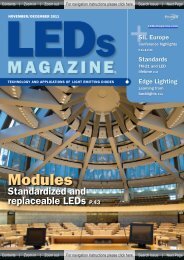Zoom In - Beriled
Zoom In - Beriled
Zoom In - Beriled
- No tags were found...
You also want an ePaper? Increase the reach of your titles
YUMPU automatically turns print PDFs into web optimized ePapers that Google loves.
Previous Page | Contents | <strong>Zoom</strong> in | <strong>Zoom</strong> out | Front Cover | Search Issue | Next PageABE FMaGSlighting | DIRECTIONALa)color rendering ofobjects or features, colorhomogeneity throughout the beam, contrastat the beam edge and glare. LED solutionshave the opportunity to surpass halogenand incandescent sources with respect to thequality of light. For instance, many halogenMR16 lamps exhibit hot spots, shadows, darkrings and fringe edge patterns. Because of thedirectional nature of LEDs, well-designedLED sources can produce a uniform beamwith a smooth gradient of light with well-controlledbeam and without the stray light thatcreates an uncomfortable glare.Lighting design specificationsLED sources need to adopt lighting industrystandards and specifications so thatdesigners can more readily specify them.When selecting accent light sources, designersconsider footcandles (lux) in the targetarea. They work with center beam footcandles(lux) and the light distribution in distancefrom the source and center beam. IESlight distribution files make it easy to designwith lamps and modules. Light color measurementsthat help a designer know how touse a light source include color temperature(CCT) with binning aligned with ANSI colorbins and color rendering index (CRI).Directional lights are traditionallyMR16 or PAR incandescent or halogenlamps defined by wattage and beam angle.Although there is a wide range of performanceeven within the halogen and incandescentmanufacturers, it is presumed thatb)FIG. 2. LedEngin’s LuxDot (a) is adirect replacement for a halogenMR16, while the LuxSpot (b) is acompact MR16 integrated module.35 W halogen from one manufacturer willperform similarly to a 35 W lamp from a secondmanufacturer. LED solutions need to becharacterized in halogen or incandescentequivalent watts with comparable color andcolor quality. For consistency, LED productsneed to follow the newly established IESNAstandards for LED testing.Types of LED directional lightingThe easiest solution to speed adoption ofLEDs is a direct replacement of the MR16halogen lamp in a standard form-factorsuch as the MR16 bi-pin (GU5.3) standard.The compact size offers a challenge for LEDsolutions accommodating sufficient thermalheat sink and the transformer. However, severalLED solutions are very close, and at leastone product, the LedEngin LuxDot , doesconform to the fit, form and function of atrue halogen MR16 (see Fig. 2).There are two predominant types of LEDsolution. The most common has multiple 1W or 3 W high-efficiency emitters packedwithin a 2-inch radius surrounded by a complexoptic to try to make a uniform beampattern. These products will meet or exceedboth the lumens and lm/W standards, butwill usually fail to deliver the needed footcandles(lux) to the targeted area in a wellcontrolledbeam.The second design approach is a singleemitter made of multiple LED chips closelypacked within a small footprint. The thermalchallenges are greater because of the densepacking but the optics are much better andthe beam much more uniform in color, lightgradient and overall efficient useof light. Figure 3 compares LEDsfrom both designs.While it is expedient todesign drop-in replacementlamps that fit into existingsockets, such solutions donot take full advantage of allLEDs have to offer. The longlifetimes of LEDs let us changethe way we think about lighting,in that the light source is not a consumablebut an integral part of design,and lighting fixtures need not be designedwith replacements in mind.The real breakthroughs will come whennew integrated modules take full advantageof LEDs, accommodate their unique issuesand provide attractive alternatives to currentlighting designs. <strong>In</strong>tegrated LED lightingmodules can optimize the thermal managementand drive electronics to providemaximum efficiency and usable light. Fromlow-profile under-cabinet lighting to accentor task lighting, integrated solutions thatbreak away from the existing constraintswill ultimately provide the best solutions.Challenges of working with LEDsLike virtually every other new technology,LED lighting has challenges to overcome.The good news is that evolving complementaryproducts such as electronic controls,thermal management solutions and opticswill support the adoption of LED lightingsolutions.Low voltage AC infrastructure: LEDsrequire a direct current driver to operate,but line voltages are either 120 V AC or 220V AC. There are many low-voltage applicationstoday using halogen lamps, particularlyin spot and accent lighting. These usetransformers that are either electronic ormagnetic and typically convert line voltageto 12 V AC. LED drive electronics mustwork with a wide range of non-regulatedlow voltage AC transformers and convertthe voltage into direct current to drive theLEDs. A second issue with these transformersis that they usually require a minimumpower load that is larger than the high-efficiencyLED products consume. LED driversneed to address the potential flicker causedby some of the “dirtier” transformers. Lastly,36 APRIL 2009 LEDsmagazine.comPrevious Page | Contents | <strong>Zoom</strong> in | <strong>Zoom</strong> out | Front Cover | Search Issue | Next PageABE FMaGS

















